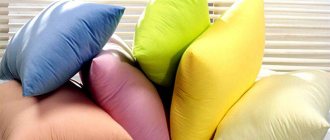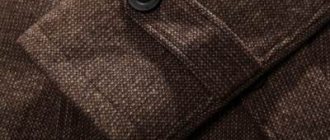The main substance found in silk is the protein fibroin. Therefore, the properties of silk differ from the properties of plant tissues.
One of these differences is sensitivity to mechanical stress and high temperature. Because of this, silk needs proper care, part of which is washing.
If you neglect it, silk fabric will not last long. Let's talk in more detail about whether silk can be washed and how to do it correctly.
Can it be washed in a washing machine, at what temperature?
Depending on the production technique, there are 3 types of silk fabric:
- natural;
- artificial;
- synthetic.
To wash silk fabric of any of these varieties, you do not have to go to the dry cleaner. If you follow simple rules, anyone can do this at home.
Natural
Silk is made from fiber produced by the silkworm larva. It is very thin and sensitive, so it is easily destroyed during washing. However, you can still wash silk fabrics.
When washing, it is important to strictly observe the temperature regime (water should not be hotter than 30 degrees) and use auxiliary products that will help not damage the fabric.
Silk fabrics are washed only by hand. Machine washable. After the first session, the canvas loses its original shape due to deformation or rupture of microscopic fibers. It becomes visible damage that looks like small stretch marks or damage to the texture.
Artificial
Artificial silk is obtained from vegetable protein or cellulose. These substances are exposed to acid. As a result, a chemical compound is obtained that is very similar in structure and properties to fibroin.
Therefore, it is also possible to wash items made from artificial silk, as is the case with natural fabrics. The same rules must be followed.
Synthetic
Synthetic silk is understood as a material that is close in properties to natural silk, but is obtained through a chemical reaction using plastics and waste from the oil refining industry. This fabric is also washable.
Washing rules are close to those of natural material . The only difference is a slightly higher water temperature, which is necessary because synthetic silk fabric absorbs sweat and other contaminants better, but is a little more difficult to clean from them.
Despite the fact that artificial or synthetic silk is somewhat stronger than natural and artificial silk, it is not advisable to wash them in a machine. However, in case of heavy soiling, machine washing is still acceptable.
Features of silk
Natural silk is quite expensive. This is due to a number of behavioral features of its threads.
- If the material is natural, then its cleaning is approached as responsibly as possible; in the case of artificial fabric, some experiments can be allowed.
- If such a fabric gets wet, the fibers become very fragile. To understand how to wash silk, you first need to understand how to soak it properly.
- It is worth noting that the use of bleaches is strictly prohibited - this is too delicate a fabric that will instantly disintegrate before your eyes.
- Drying and ironing technology is also important when working with silk. If you approach this issue incorrectly, then a great blouse can suddenly turn into something that has no shape.
Step-by-step washing instructions
Let's look at the step-by-step process of washing different types of silk fabrics.
How to wash natural?
To wash a natural silk item, you will need the following:
- container for washing (a plastic or metal basin is suitable);
- water with a temperature not exceeding 30 degrees Celsius;
- a special detergent intended exclusively for silk items (for example, Luxus Professional powder);
- table vinegar 9% strength.
You need to do the following:
Fill the basin with cool water, the temperature of which should not exceed 30 degrees Celsius.- Dilute in it a detergent intended for hand washing silk fabrics.
- Dip the item in water and wash it with light movements without applying excessive pressure.
- Remove the item and squeeze it out very carefully (without twisting).
- Pour out the soapy water and instead fill the basin with clean water, which should be about 5 degrees Celsius cooler.
- Gently rinse the item.
- Drain the water and fill the basin with clean water.
- Add 9% strength table vinegar to the water at the rate of 5 tablespoons per 10 liters.
- Rinse the silk item in the resulting solution.
- Let the liquid drain from the item without squeezing.
- To remove excess moisture, place the washed item in a terry towel.
- When the towel has absorbed the liquid as much as possible, remove the item from it.
Silk items should not be hung to dry on a clothesline. As a result of such drying, microfibers can be damaged, after which the fabric will lose its original appearance and become ugly.
Artificial processing
The algorithm for washing items made from artificial silk does not differ from that for washing items made from natural material. However, the procedure can be simplified by eliminating rinsing in a vinegar solution.
Also, artificial fabric can be machine washed if it is heavily soiled. In this case, you must adhere to the following rules:
use the lowest possible washing temperature (on most models of washing machines it is 40 degrees Celsius);- set the minimum possible drum speed (usually 300-400 rpm);
- choose the most delicate washing modes (usually they are called “Silk”, “Hand Wash” and the like);
- Before washing, the item is placed in a mesh bag (this prevents friction against the metal walls of the drum);
- do not turn on the spin and additional rinse modes.
When machine washing, you must add special products to the powder that help avoid mechanical damage to the item. Examples include CRYSTAL and Nikwax Down Wash.
If possible, even rayon items should not be machine washed. This is done only because, due to their lower cost, it is not as bad to lose them as natural ones.
Cleaning synthetic silk fabric
The procedure for washing synthetic silk is similar. The difference is that if it is washed by hand, you can increase the water temperature to 40 degrees Celsius .
Drying and ironing products
After washing and rinsing, items should not be hung vertically on a rope and secured with clothespins, otherwise marks and creases will remain. For hanging, hangers, a thick rope or a cylindrical holder through which you can throw the item are suitable. It is better to lay it out on a soft surface to dry at room temperature or in the shade in an open space. Bed linen is straightened on a line or dryer to drain the water. Exposure to hot air should be avoided.
- It is recommended to start ironing when the clothes or linen are still damp. Overdried silk is difficult to smooth out, and water leaves stains.
- You need to iron delicate material with an iron in the “silk” mode only from the wrong side through the iron. The steam and humidification function should be turned off.
- Steaming is possible only in a vertical position, without contact with the fabric. In case of complex, irremovable folds, you will have to completely wet the item a second time, blot it, and repeat the procedure.
- Some fabrics, such as crepes, may shrink during washing. They are ironed wet, and the fabric is slightly stretched under the iron.
How to preserve the color of an item?
To avoid loss of color, the washed item is rinsed in a vinegar solution, as mentioned above. However, there are other ways to preserve color. The simplest of them is adding starch to water.
To do this, perform the following steps:
Potato starch is added to water at a temperature not exceeding 30 degrees Celsius at the rate of 3-4 tablespoons per 10 liters of liquid;- they place a silk item there;
- cover the container with the item with a lid and leave it for 2-3 hours;
- the item is taken out and washed using detergents, and then rinsed;
- after the first rinse, prepare a water-alcohol solution at the rate of 1-2 tablespoons of ethyl alcohol per 10 liters of water;
- The item is rinsed in the resulting solution.
Instead of alcohol, you can use vodka. In this case, add 3-4 tablespoons of alcohol to the water.
Also, to preserve or refresh color, special compounds are widely used, which can be purchased at household chemical stores.
Often their use is more effective than using vinegar or starch with alcohol. An example of such compositions is the Woolite line of gels.
How to bleach?
There are three ways to bleach a silk product
- Using sea salt.
- By increasing the temperature.
- Using special means.
Let's look at each of them.
Sea salt
To whiten with sea salt you will need:
- sea salt;
- washing powder for silk fabric;
- ammonia;
- hydrogen peroxide.
You need to do the following:
- Wash and rinse the silk item as described above.
- Dilute 8 tablespoons of sea salt, 15 ml of ammonia and 30 ml of hydrogen peroxide in 10 liters of water.
- Place a silk product in the resulting solution and leave it for 5 hours, covering it with a lid.
- Remove the item and rinse it twice in cool water.
Temperature increase
To bleach by increasing the temperature, you will need laundry soap and bulky metal utensils. To carry out the procedure, you must perform the following steps:
- Dissolve 1 bar of laundry soap in 10 liters of water;
- place a silk item in the resulting solution;
- place the container with the product on the stove and heat to 90 degrees Celsius;
- cool the item slowly;
- After cooling, remove it and rinse twice in cold water.
This method can seriously damage the silk, so should only be used if there is a significant color change. For natural silk fabrics it is better not to use it at all.
Special means
The simplest, most affordable and safest way to whiten is to use special products that can be purchased at household chemical stores.
Usually you need to soak the item in their solution for a while or add them during washing. An example of such a product is the popular Vanish bleach.
Production technology
Silk is created from the cocoons of silkworms. As soon as they are born, the caterpillars begin to eat mulberry leaves. Within 40 days, the insects increase in size 10 times and begin to spin a cocoon from their own saliva.
Finished cocoons are collected, cleaned and sorted. Next, you need to untangle the threads of the cocoon; to do this, they are dipped in hot water, which helps clean the threads from the sericin that glues them together. The threads from which the cocoon is woven are thin, therefore, to create the blank from which the material will be woven, several threads are intertwined.
Initially, the silk thread has a yellowish tint, so before starting to make the material itself, it is bleached and dyed. An alkaline solution is used for bleaching. The silk thread is soaked in the solution for 9–13 hours, stirring occasionally. Then they move on to coloring. Natural and chemical agents are used as dyes.
After dyeing, the material is subjected to “revitalization”. This stage gives the colors richness and the threads themselves shine. To do this, they are treated with the essence of acetic acid. The last stage is decatification (steam treatment). This process relieves structural tension within the threads themselves. After much preparation, you can finally move on to creating the fabric.
How to remove stains?
Typically, stains from silk fabric are removed using special stain removers. But if they are not at hand, you can use other methods. Let's look at ways to remove stains of various origins.
Sweat, perfume ink
To remove stains from sweat, perfume or ink, use ethyl alcohol.
To remove a stain, perform the following steps:
- the item is placed on a flat surface and smoothed;
- pour 1 tablespoon of ethyl alcohol or vodka onto the stain and wait 3-5 minutes.
Then the silk product is washed.
Fat and oil
Grease and oil stains can be removed with turpentine. It dissolves these substances, but does not harm the canvas. To remove a stain, you need to do the following:
- place the item on a flat surface;
- moisten a piece of cotton cloth with 2 tablespoons of turpentine;
- blot the stain with a cloth several times until it disappears.
Afterwards the item needs to be washed.
There is no need to use more turpentine, as it itself can leave a stain on the fabric.
Drinks and low-fat foods
Glycerin removes stains from drinks (tea, coffee, alcohol) and low-fat foods.
The substance can be purchased at a pharmacy. It is available without a prescription. To remove a glycerin stain, you need to follow these steps:
- place the item on a flat surface;
- Wipe the stain with a piece of cotton cloth or a cotton pad soaked in glycerin.
If the stain is very ingrained, proceed as follows:
- Apply 10-15 drops of glycerin to the stain;
- sprinkle the contaminated area with ½ teaspoon of table salt;
- leave for 10 minutes;
- wash off the salt and glycerin with cool water.
Upon completion of both versions of the procedure, the silk product is washed.
Blood
Blood stains are removed with starch. To do this, perform the following steps:
- add 2-3 tablespoons of starch to 100 ml of warm water and let the mixture brew for 30-40 minutes;
- place the item on a flat surface;
- 1-2 teaspoons of the resulting paste are applied in a thin layer to the stain;
- leave the item for 20-30 minutes;
- wash off the paste with cool water.
After the procedure, the silk item must be washed.
Household chemicals
that can be purchased at household chemical stores also effectively remove stains
An example is the Weasel Delicate Wash. It is dissolved in water at the rate of 50 ml of gel per 10 liters of water. No powder is added.
The product removes not only dirt, but also stains.
Quality of silk fabric
The beauty of silk and its practical advantages contribute to the popularity of this fabric in many areas of industry, not to mention the fashion world.
Silk is especially actively used by famous Italian brands. The texture of the fabric allows you to turn the fantastic ideas of designers into reality. Its incredible lightness, shimmering shine and at the same time amazing strength allow the fabric to be used in sewing a wide variety of clothes. In addition to the peculiarities of the weaves, the quality and beauty of the fabric is influenced by the rearing of silkworm caterpillars. For example, if the fabric label says “100% KBT SEIDE” (100% silk) or “ORGANIC SEIDE”, then this means that the material is environmentally friendly. That is, when raising silkworms, selected foliage was used to feed it, hormones were not used to accelerate the growth and size of insects, and mulberries were not treated with harmful chemicals. The quality of the fiber depends on the leaves on which the caterpillars feed.
If they are fed oak leaves, they get coarser fibers.
Today, most women can afford to buy natural silk fabric. However, there are also those whose family budget does not allow them to do this. Viscose and various synthetic fabrics have long been used as such materials. Naturally, the price of these materials is much lower.
How to dry it?
Since silk fibers are very sensitive to physical stress, they can break even if hung on a clothesline under the weight of wet fabric. Therefore, drying silk items requires a special approach.
To dry the product, lay it out on a flat surface and wait until the moisture has completely evaporated . In this case, it is undesirable for the fabric to be exposed to direct sunlight.
You will find maximum useful information about washing clothes and various fabric products here.











